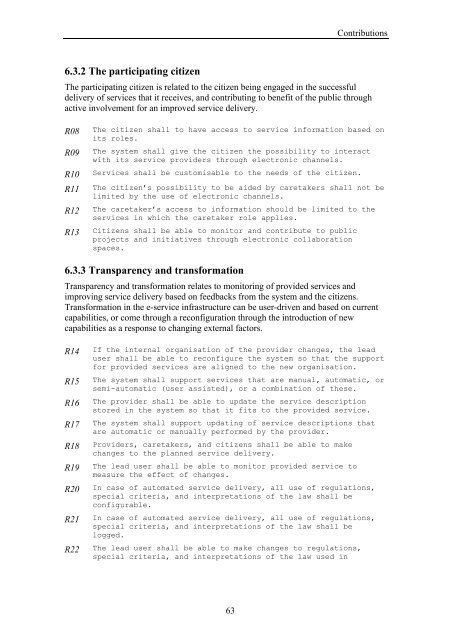Multi-channel provisioning of public services - Department of ...
Multi-channel provisioning of public services - Department of ...
Multi-channel provisioning of public services - Department of ...
You also want an ePaper? Increase the reach of your titles
YUMPU automatically turns print PDFs into web optimized ePapers that Google loves.
Contributions<br />
6.3.2 The participating citizen<br />
The participating citizen is related to the citizen being engaged in the successful<br />
delivery <strong>of</strong> <strong>services</strong> that it receives, and contributing to benefit <strong>of</strong> the <strong>public</strong> through<br />
active involvement for an improved service delivery.<br />
R08<br />
R09<br />
R10<br />
R11<br />
R12<br />
R13<br />
The citizen shall to have access to service information based on<br />
its roles.<br />
The system shall give the citizen the possibility to interact<br />
with its service providers through electronic <strong>channel</strong>s.<br />
Services shall be customisable to the needs <strong>of</strong> the citizen.<br />
The citizen’s possibility to be aided by caretakers shall not be<br />
limited by the use <strong>of</strong> electronic <strong>channel</strong>s.<br />
The caretaker’s access to information should be limited to the<br />
<strong>services</strong> in which the caretaker role applies.<br />
Citizens shall be able to monitor and contribute to <strong>public</strong><br />
projects and initiatives through electronic collaboration<br />
spaces.<br />
6.3.3 Transparency and transformation<br />
Transparency and transformation relates to monitoring <strong>of</strong> provided <strong>services</strong> and<br />
improving service delivery based on feedbacks from the system and the citizens.<br />
Transformation in the e-service infrastructure can be user-driven and based on current<br />
capabilities, or come through a reconfiguration through the introduction <strong>of</strong> new<br />
capabilities as a response to changing external factors.<br />
R14<br />
R15<br />
R16<br />
R17<br />
R18<br />
R19<br />
R20<br />
R21<br />
R22<br />
If the internal organisation <strong>of</strong> the provider changes, the lead<br />
user shall be able to reconfigure the system so that the support<br />
for provided <strong>services</strong> are aligned to the new organisation.<br />
The system shall support <strong>services</strong> that are manual, automatic, or<br />
semi-automatic (user assisted), or a combination <strong>of</strong> these.<br />
The provider shall be able to update the service description<br />
stored in the system so that it fits to the provided service.<br />
The system shall support updating <strong>of</strong> service descriptions that<br />
are automatic or manually performed by the provider.<br />
Providers, caretakers, and citizens shall be able to make<br />
changes to the planned service delivery.<br />
The lead user shall be able to monitor provided service to<br />
measure the effect <strong>of</strong> changes.<br />
In case <strong>of</strong> automated service delivery, all use <strong>of</strong> regulations,<br />
special criteria, and interpretations <strong>of</strong> the law shall be<br />
configurable.<br />
In case <strong>of</strong> automated service delivery, all use <strong>of</strong> regulations,<br />
special criteria, and interpretations <strong>of</strong> the law shall be<br />
logged.<br />
The lead user shall be able to make changes to regulations,<br />
special criteria, and interpretations <strong>of</strong> the law used in<br />
63
















